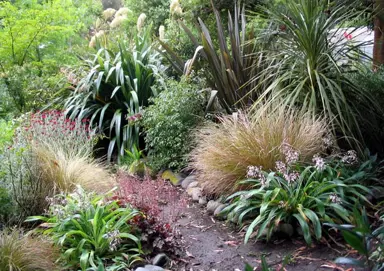
Tamarillo, also known as the tree tomato, is a fast-growing fruit tree prized for its delicious, tangy fruit. Ideal for home gardens and orchards, tamarillos thrive in New Zealand’s temperate climate, providing fresh, nutritious fruit throughout the season.
Tamarillo 'Tango' is a vibrant, red-skinned tamarillo variety prized for its rich flavour and high yields. This fast-growing, subtropical tree...
Tamarillo Mulligan is a variety of Tamarillo which produces exquisite and tasty fruit. White flowers appear in spring and are followed by the...
At The Plant Company, we offer a range of tamarillo varieties suited to New Zealand conditions, including red, gold, and yellow fruit types. Each variety is chosen for flavour, yield, and adaptability, giving gardeners plenty of options for tasty harvests.
Tamarillo plants prefer full sun and well-drained soil with good organic content. They need protection from strong winds and frost, particularly when young. Regular watering and feeding during the growing season encourage healthy growth and fruit production.
Our tamarillo plants are NZ-grown, healthy, and ready to fruit. We provide fast, reliable nationwide delivery and expert advice to help you grow and harvest delicious tamarillos. Order online today to enjoy fresh, homegrown fruit.
Tamarillo, also known as tree tomato, is an exotic fruit native to South America, with a unique flavor and a variety of interesting facts. Here are some fascinating facts about tamarillos:
In conclusion, tamarillo is a fascinating fruit with a unique flavor, nutritional value, and cultural significance. Its versatility in culinary applications, potential medicinal properties, and ease of cultivation make it a valuable addition to gardens and diets. As people become more aware of the unique qualities of tamarillo, it is likely to gain wider recognition and popularity around the world.
Tamarillo trees thrive in specific environmental conditions that favor their growth and productivity. Here's a summary of the ideal conditions for tamarillo trees:
By providing these optimal conditions, you can help your tamarillo trees flourish and produce an abundance of delicious fruits for years to come. Remember that even with proper care, tamarillo trees may take a few years to mature and start bearing fruit.
Tamarillo trees have a lifespan of approximately 7-12 years. However, with proper care and ideal growing conditions, they can live for up to 15 years or even longer. Regular watering, fertiliser applications, pruning, and protection from pests and diseases can significantly extend the life of a tamarillo tree.
Diagnosing problems with Tamarillo trees can be challenging, as various factors can contribute to their decline. However, by observing the tree's symptoms and environmental conditions, you can identify the likely causes and take appropriate corrective measures.
Here are some common problems that can affect Tamarillo trees and their potential causes:
Remember that diagnosing and addressing problems with Tamarillo trees requires careful observation, understanding of the plant's needs, and appropriate care practices.
Tamarillo trees typically take 2-3 years to produce fruit from the time of planting. However, the exact time may vary depending on various factors, including the specific variety of tamarillo, growing conditions, and overall plant health.
Under ideal conditions, with warm temperatures, well-drained soil, and ample sunlight, a tamarillo tree may start fruiting as early as the second year. However, in cooler climates or with less favorable growing conditions, it may take up to three or four years for the tree to mature enough to produce fruit.
Yes, it is possible to grow tamarillo trees in New Zealand, but it requires certain conditions and careful attention to their needs. Tamarillos are subtropical fruits native to the Andean region of South America, and they prefer warm, frost-free climates with well-drained soil and ample sunlight.
While tamarillo trees are self-fertile, meaning they can produce fruit without pollination from another tree, having two or more tamarillo trees can increase fruit production. Cross-pollination between different varieties of tamarillo trees can lead to larger, more abundant fruits. Additionally, having multiple tamarillo trees can help to ensure pollination even if one tree is not flowering or pollinating effectively.
Yes, tamarillo trees are considered fast-growing fruit trees. They typically take 2-3 years to fruit from the time of planting, and they can reach full maturity within 5-7 years. During their active growing season, tamarillo trees can grow up to 2 feet (60 cm) per year.
Here are some factors that can affect the growth rate of tamarillo trees:
By maintaining optimal growing conditions and addressing any potential issues promptly, you can help your tamarillo tree grow quickly and reach its full fruiting potential.
Whether you need assistance finding the plant you’re looking for or you simply want to know more about who we are and what we do, we invite you to get in touch with us today. A member of The Plant Company team will get back in touch as soon as possible.


